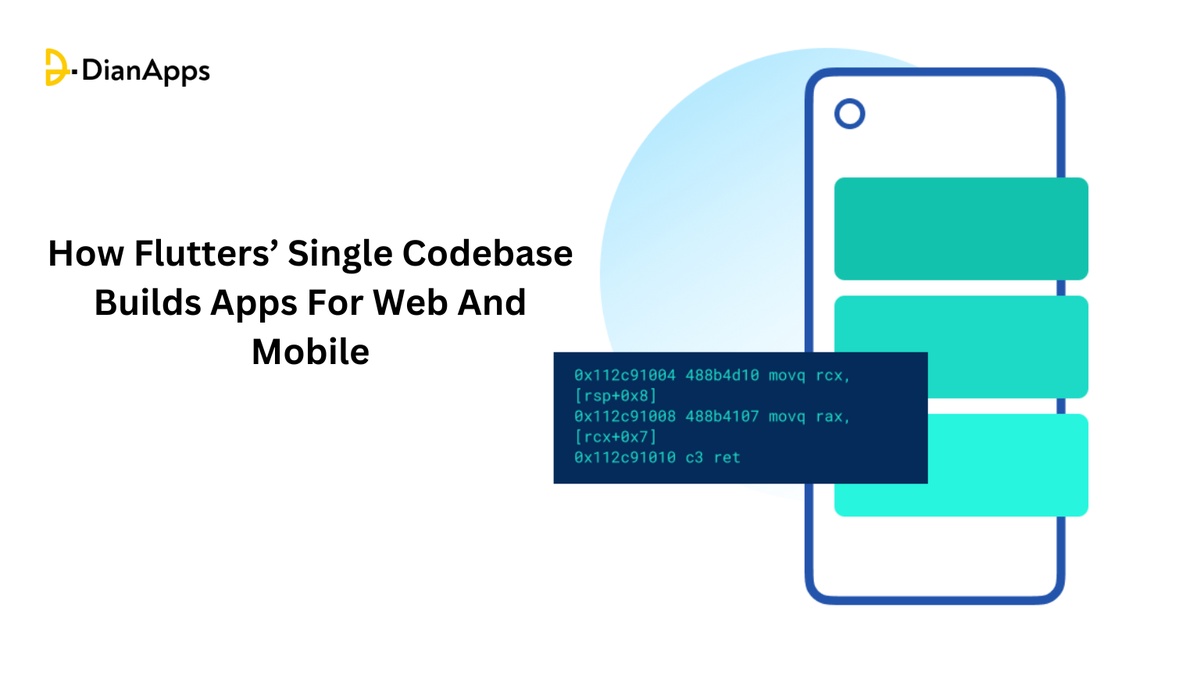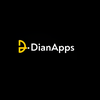The use of Flutter in app development is breaking the chain of providing basic-level development solutions. From building seamless mobile apps to creating compelling website app services, the framework is responsive to all your business needs.
A report by Google states that approximately 100,000 apps have already been launched since the framework was first released. How exciting is that?
But what makes Flutter so different from other technological frameworks? While there are many pointers to highlight, the very critical feature that made this 2017 incepted open-sourced framework popular is its ability to build apps using a single codebase.
Now, developers can create impressive and complex UIs with ease, and they won’t have to rewrite the code for building web applications separately. This unveils the possibilities of fast and better-performing web and mobile applications.
Want to know how Flutters’ single codebase can automate your web and mobile app development needs extensively? This blog is your passway to unlocking the chances of saving money and creating web and mobile applications that can be launched instantly.
Let’s see how Flutters’ single codebase builds web and mobile apps.
What is Flutter? An Overview of the Framework
Flutter is an open-source mobile application development framework created by Google. It is used to develop applications for iOS, Android, and the web from a single codebase. Flutter uses the Dart programming language, which is also developed by Google.
Flutter's key feature is its "hot reload" functionality, which allows developers to quickly see the changes they've made to the code reflected in the app's user interface. This feature speeds up the development process significantly and makes it easier for developers to iterate on their code.
Flutter also comes with a rich set of pre-built widgets that allow developers to create beautiful, responsive, and customizable user interfaces for their apps. These widgets are designed to work seamlessly across multiple platforms, ensuring that the app looks and feels consistent regardless of the platform it is being used on.
Overall, Flutter is a powerful and flexible framework that is rapidly gaining popularity among developers. Its ease of use, fast development cycle, and cross-platform capabilities make it an attractive choice for building mobile and web applications.
Let’s know the advantages of using Flutters’ single codebase facility to build apps on the web and mobile in detail below.
Advantages of Flutter’s Single Codebase to Build Apps On Web And Mobile
There are several advantages to using Flutter's single codebase facility to build apps for both web and mobile platforms. Here are some of the key benefits:
- Faster development: Using a single codebase for both web and mobile development can significantly speed up the development process. Developers only need to write code once, and they can deploy it to both platforms without having to make significant changes.
- Consistent user experience: With Flutter, developers can create user interfaces that look and feel native on both mobile and web platforms. This means that users can enjoy a consistent experience, regardless of the platform they are using.
- Lower development costs: Developing apps for multiple platforms can be expensive. However, with Flutter, developers can save money by using a single codebase for both web and mobile development. This means they can avoid the costs associated with maintaining separate codebases for each platform.
- Easier maintenance: Maintaining separate codebases for each platform can be challenging, as developers need to make sure that each codebase is up-to-date and functioning correctly. However, with Flutter, developers only need to maintain a single codebase, making it easier to keep the app up-to-date and fix bugs.
- Faster updates: Updating an app can be time-consuming, especially if the app is available on multiple platforms. However, with Flutter's single codebase facility, developers can update the app quickly and easily, and the changes will be reflected on both web and mobile platforms.
Overall, using Flutter's single codebase facility to build apps for both web and mobile platforms can save time, reduce costs, and improve the user experience.
Requirements To Build Web & Mobile Apps Using Flutters’ Single Codebase
To build both web and mobile apps using Flutter's single codebase facility, you need to meet the following requirements:
Flutter SDK:
You need to have the Flutter SDK installed on your development machine. This includes the Flutter framework and the Dart programming language.
Flutter for web:
You need to install the Flutter for web tool, which allows you to compile your Flutter code into web-compatible JavaScript code.
Widgets:
You need to use widgets that are compatible with both mobile and web platforms. Fortunately, Flutter comes with a rich set of pre-built widgets that are designed to work seamlessly across multiple platforms.
Design guidelines:
When designing your app, you should follow the design guidelines for both mobile and web platforms. This will ensure that your app looks and feels native on both platforms.
Responsive design:
Since the screen sizes of mobile and web devices can vary significantly, it's important to use responsive design techniques to ensure that your app looks good on all devices.
Browser compatibility:
You need to test your app on multiple web browsers to ensure that it works correctly on all of them.
By meeting these requirements, you can build both web and mobile apps using a single Flutter codebase. This can save time and effort, and ensure a consistent user experience across multiple platforms.
For you to get a clear understanding of the code, here is an example of the different screen layout that includes just one coding infrastructure that can run on multiple devices seamlessly. This example is a default code showcasing a basic flutter application.
Default code when you create a basic flutter web and mobile app
When you create a basic Flutter app using the command flutter create <app_name>, the default code in the main.dart file is:
import 'package:flutter/material.dart';
void main() {
runApp(MyApp());
}
class MyApp extends StatelessWidget {
@override
Widget build(BuildContext context) {
return MaterialApp(
title: 'Flutter Demo',
theme: ThemeData(
primarySwatch: Colors.blue,
),
home: MyHomePage(title: 'Flutter Demo Home Page'),
);
}
}
class MyHomePage extends StatefulWidget {
MyHomePage({Key? key, required this.title}) : super(key: key);
final String title;
@override
_MyHomePageState createState() => _MyHomePageState();
}
class _MyHomePageState extends State<MyHomePage> {
int _counter = 0;
void _incrementCounter() {
setState(() {
_counter++;
});
}
@override
Widget build(BuildContext context) {
return Scaffold(
appBar: AppBar(
title: Text(widget.title),
),
body: Center(
child: Column(
mainAxisAlignment: MainAxisAlignment.center,
children: <Widget>[
Text(
'You have pushed the button this many times:',
),
Text(
'$_counter',
style: Theme.of(context).textTheme.headline4,
),
],
),
),
floatingActionButton: FloatingActionButton(
onPressed: _incrementCounter,
tooltip: 'Increment',
child: Icon(Icons.add),
),
);
}
}
After “flutter run” command, this is how your screen will look on mobile phones:
And this is how your web application will look like:
But setting up your web and mobile application may be difficult if you do it alone. Therefore, you need a professional's guidance. Here’s how an app development company can help.
Why Should Businesses Choose Flutter App Development Company for Web & Mobile Apps?
There are several reasons why businesses should consider choosing a Flutter app development company for building web and mobile apps:
- Cross-platform development: Flutter allows developers to create apps for both mobile and web platforms from a single codebase, which can save businesses time and money in the long run. By using a single codebase, developers can avoid the need to build separate apps for each platform.
- Fast development: Flutter's hot reload feature allows developers to see changes they make to the code reflected in the app's user interface in real-time. This can speed up the development process significantly, making it easier for businesses to get their apps to market quickly.
- Rich set of widgets: Flutter comes with a rich set of pre-built widgets that can be used to create beautiful, responsive, and customizable user interfaces for apps. These widgets are designed to work seamlessly across multiple platforms, ensuring that the app looks and feels consistent regardless of the platform it is being used on.
- Cost-effective: Since Flutter allows developers to create apps for both mobile and web platforms from a single codebase, businesses can save money on development costs. This can be especially beneficial for small businesses and startups with limited budgets.
- Better user experience: Flutter's widgets are designed to provide a native look and feel on both mobile and web platforms, which can help to improve the user experience. By providing a consistent user experience across multiple platforms, businesses can improve user satisfaction and increase user engagement.
- Strong community support: Flutter has a strong and growing community of developers, which means that businesses can easily find resources and support when building their apps. This can be especially helpful for businesses that are new to app development or have limited in-house development resources.
Flutter app development can provide businesses with a cost-effective and efficient way to build high-quality apps for both mobile and web platforms. By choosing a Flutter app development company, businesses can take advantage of the platform's unique features and capabilities, and create apps that provide a great user experience across multiple platforms.
Wrapping Up
Flutter is a powerful and reliable SDK platform for your web and mobile app development needs! Need your app to be developed quickly? Now you know with Flutters’ single codebase functionality, you can create an app that can run on multiple devices.
This was our take on providing the details on Flutters’ codebase in building apps that runs seamlessly on both web and mobile infrastructure. Not just them, Flutter is also responsive on desktop, Linux, and cloud platforms.
Need more information? Reach out to us and will assist you in every possible way.
Article source: https://medium.com/@marketing_96275/how-flutters-single-codebase-builds-apps-for-web-and-mobile-3cbc1d32b016


No comments yet